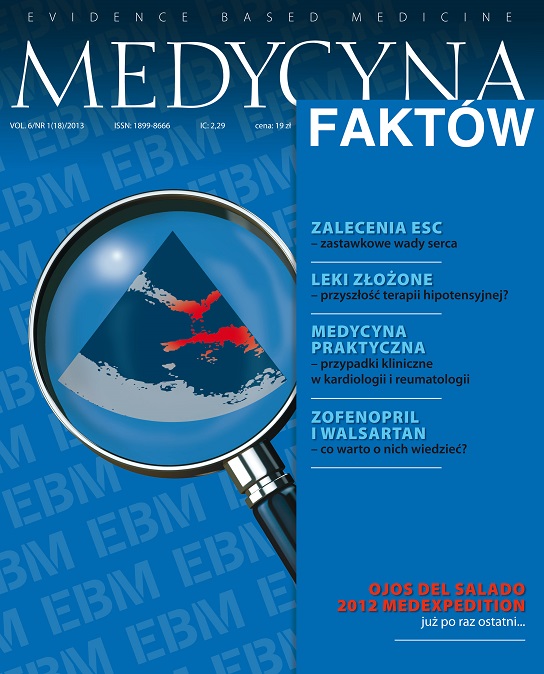Niewydolność serca – jak jeszcze możemy zintensyfikować farmakoterapię? Opis przypadku
##plugins.themes.bootstrap3.article.main##
Abstrakt
Pacjenci z przewlekłą niewydolnością serca, zwłaszcza z upośledzoną funkcją skurczową lewej komory, odnoszą korzyści ze zwolnienia spoczynkowej czynności serca poniżej 70/min, co zostało udowodnione w licznych badaniach klinicznych. Badanie SHIFT pokazało, że w przypadku trudności z uzyskaniem pożądanej spoczynkowej czynności serca, mimo stosowania β-adrenolityku w maksymalnej dawce lub jeżeli zwiększenie jego dawki nie jest możliwe, skuteczne może się okazać dołączenie iwabradyny. W rozdziale przedstawiono dwa przypadki chorych z praktyki klinicznej, u których dzięki dołączeniu iwabradyny udało się skutecznie obniżyć spoczynkową czynność serca. Opisano 73-letnią kobietę z przewlekłą pozawałową niewydolnością serca oraz upośledzoną funkcją skurczową lewej komory (EF ok. 30%), u której mimo stosowania β-adrenolityku w maksymalnej dawce nie uzyskano pożądanego zwolnienia czynności serca. Dołączenie do leczenia iwabradyny pozwoliło osiągnąć zamierzony efekt kliniczny. W drugim przypadku, u 64-letniej kobiety z przewlekłą pozawałową niewydolnością serca, otyłością i POChP, nietolerującej dużych dawek β-adrenolityku, zastosowanie iwabradyny również skutecznie obniżyło czynność serca.
##plugins.themes.bootstrap3.article.details##
Copyright © by Medical Education. All rights reserved.
Bibliografia
2. Fox K., Ford I., Steg P.G. et al.; BEAUTIFUL investigators: Heart rate as a prognostic risk factor in patients with coronary artery disease and left-ventricular systolic dysfunction (BEAUTIFUL): a subgroup analysis of a randomised controlled trial. Lancet 2008; 372: 817-821.
3. Kolloch R., Legler U.F., Champion A. et al.: Impact of resting heart rate on outcomes in hypertensive patients with coronary artery disease: findings from the INternationalVErapamil-SR/trandolaprilSTudy (INVEST). Eur. Heart J. 2008; 29: 1327-1334.
4. Böhm M. , Swedberg K., Komajda M., et al., on behalf of the SHIFT Investigators: Heart rate as a risk factor in chronic heart failure (SHIFT): the association between heart rate and outcomes in a randomised placebo-controlled trial. Lancet 2010; 376: 886-894.
5. Böhm M., Borer J., Ford I. et al.: Heart rate at baseline influences the effect of ivabradine on cardiovascular outcomes in chronic heart failure: analysis from the SHIFT study. Clin. Res. Cardiol. [online: DOI 10.1007/s00392-012-0467-8].
6. Komajda M., Böhm M., Borer J. et al.: Influence of background treatment with mineralocorticoid receptor antagonists on ivabradine’s effects in patients with chronic heart failure. European Journal of Heart Failure [online: doi:10.1093/eurjhf/hfs127].
7. Christensen L.P., Zhang R., Zheng W. et al.: Postmyocardial infarction remodeling and coronary reserve: effects of ivabradine and beta blocade therapy. Am. J. Physiol. Heart Circ. Physiol. 2009; 297: H322-H330.
8. ESC Guidelines for the diagnosis and treatment of acute and chronic heart failure 2012; The Task Force for the Diagnosis and Treatment of Acute and Chronic Heart Failure 2012 of the European Society of Cardiology Developed in collaboration with the Heart Failure Association (HFA) of the ESC. Eur. Heart J. 2012; 33: 1787-1847.
9. Jankowska E.A., Kurian B., Banasiak W., Ponikowski P.: Are there relationships between high resting heartrate and not optimal doses of betablockers inoutpatients with systolic heart failure incontemporary Poland? Results of DATA-HELP study. Eur. Heart J. 2012; 33(Suppl. 1): 808.
